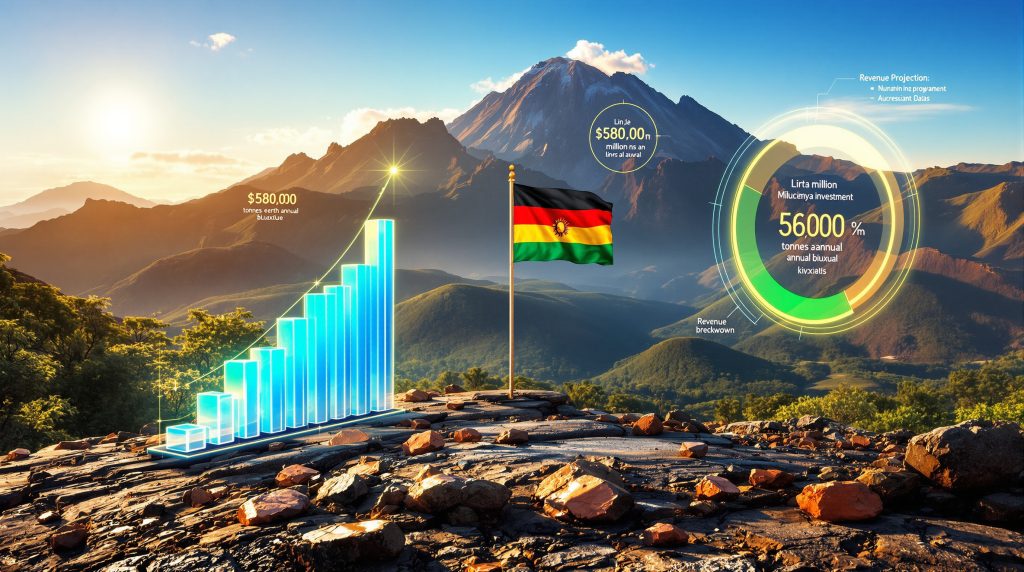The Mount Mulanje mining proposal has ignited unprecedented controversy in Malawi, as the nation grapples with balancing economic opportunities against environmental preservation at this sacred UNESCO World Heritage Site. This $820 million development project targeting bauxite and rare earth element extraction represents a critical juncture that could fundamentally reshape both Malawi's economic trajectory and the future of one of Africa's most treasured natural landmarks.
Understanding the Scale and Scope of the Proposed Development
The Mount Mulanje mining proposal represents one of the most ambitious industrial projects in Malawi's history. Akatswiri Mineral Resources has outlined plans to extract valuable minerals from the Lichenya and Linje plateaus, transforming this sacred landscape into an active mining zone.
The project's scale demonstrates significant ambition, with annual bauxite extraction targets reaching 580,000 tonnes and projected aluminum production of 100,000 tonnes annually. These figures position the development as a major industrial undertaking that could fundamentally alter Malawi's economic landscape. Furthermore, understanding these bauxite project benefits requires comprehensive analysis of both immediate and long-term implications.
Key Project Specifications Include:
- Annual bauxite extraction target: 580,000 tonnes
- Projected aluminum production: 100,000 tonnes annually
- Estimated annual revenue generation: $260 million
- Direct employment creation: Over 1,300 positions
- Infrastructure requirements: Aerial ropeway systems and railway connections
The mining initiative would require substantial infrastructure development, including specialized transportation systems designed to navigate the challenging terrain of Mount Mulanje's granite massif. These infrastructure investments represent a significant portion of the overall project cost and highlight the technical complexity of extracting resources from this elevated location.
Economic Transformation Potential for Malawi
The financial implications of the Mount Mulanje mining proposal extend far beyond immediate job creation, potentially affecting multiple sectors of Malawi's economy. With the country's GDP standing at approximately $9.4 billion in 2023, the projected $260 million in annual revenue would represent roughly 2.8% of the nation's total economic output.
Malawi's current export structure relies heavily on agricultural products, particularly tobacco, tea, sugar, and coffee. The introduction of industrial mineral exports would diversify this economic base, potentially reducing vulnerability to agricultural market fluctuations and climate-related production challenges.
Employment Structure Analysis:
The projected workforce distribution spans multiple skill levels and operational areas:
- Mining operations: 600 positions
- Processing facilities: 300 positions
- Transportation and logistics: 200 positions
- Administrative and support: 100 positions
However, a critical contradiction emerges when examining processing capabilities. While employment projections include processing facility positions, Malawi currently lacks both the energy infrastructure and refining capacity to process bauxite or rare earth elements locally. This limitation suggests the country would primarily export raw materials, capturing less value from mineral extraction than fully integrated operations would provide.
The energy requirements for aluminum production present substantial challenges. Aluminum smelting typically requires 12-16 MWh per tonne of production, meaning the proposed 100,000 tonnes of annual aluminum production would demand approximately 171 MW of continuous electricity supply. This represents 25-50% of Malawi's current national peak demand, creating significant strain on existing energy infrastructure.
Environmental Risks Threatening Mount Mulanje's Ecosystem
Mount Mulanje supports unique ecological communities that have evolved in isolation over millennia. The mountain's granite massif creates distinct microclimates supporting species found nowhere else on Earth, making environmental protection concerns particularly acute for this UNESCO World Heritage Site.
The Mulanje cedar (Widdringtonia cedarbergensis) represents one of the most significant conservation concerns. This endemic coniferous species has already been severely depleted by illegal logging, with only 5-10% of its historical range remaining. Open-pit mining operations would further threaten these remnant populations through direct habitat destruction and altered watershed dynamics.
Critical Environmental Assets at Risk:
- Endemic plant species: Approximately 200-250 plant species found nowhere else on Earth
- Mulanje Apalis: Critically endangered endemic bird species
- Watershed systems: Serving over 800,000 people in Blantyre and surrounding areas
- High-altitude grasslands: Supporting rare plant communities adapted to specific elevation zones
Open-pit bauxite mining typically disturbs 2-3 hectares per million tonnes of annual production. At the proposed extraction rate of 580,000 tonnes annually, approximately 1,200-1,700 hectares would face direct disturbance. Additionally, bauxite mining produces 3-4 tonnes of waste rock per tonne of ore, generating 1.74-2.32 million tonnes of overburden annually that requires permanent storage and management.
The hydrological impacts pose particularly severe risks for downstream communities. Mine dewatering operations typically lower water tables 50-150 meters in surrounding areas, with effects often persisting 10-30 years post-closure. For a mountain that functions as a natural water tower, these impacts could fundamentally alter water availability for municipal supply, agriculture, and ecosystem maintenance. Consequently, implementing effective mine reclamation innovation becomes crucial for long-term environmental restoration.
UNESCO World Heritage Status Complications
Mount Mulanje's designation as Malawi's first UNESCO World Heritage Site in 2023 creates binding international obligations that extend beyond national sovereignty. This status triggers specific monitoring protocols and potential intervention mechanisms that complicate mining development plans. According to recent reports on Malawi's sacred UNESCO mountain facing mining threats, local communities and conservationists have expressed significant opposition to the proposal.
UNESCO Protection Framework Requirements:
- Mandatory Environmental and Social Impact Assessments for major developments
- International monitoring committee oversight and regular reporting
- Potential "World Heritage in Danger" listing if threats are identified
- Tourism and cultural preservation mandate integration
The UNESCO designation recognizes Mount Mulanje as covering approximately 56,000 hectares and representing outstanding universal value through its unique biodiversity and cultural significance. Mining operations would directly contradict the conservation objectives underlying this international recognition.
Local communities regard Mount Mulanje as sacred territory, integral to traditional belief systems and cultural identity. This spiritual dimension adds complexity to purely economic calculations and strengthens opposition to industrial development. Traditional chiefs have emphasized cultural preservation as a non-negotiable priority, creating additional social and political obstacles for mining proponents.
Infrastructure Challenges Facing the Mining Project
The technical and logistical challenges of developing Mount Mulanje present substantial obstacles that could derail the mining proposal. The mountain's elevated location and UNESCO protection status severely constrain infrastructure development options.
Energy Infrastructure Constraints
Malawi's total installed generation capacity reaches approximately 800-900 MW, with peak demand typically ranging between 450-550 MW. The mining project's estimated electricity requirement of 200-250 MW represents a substantial portion of national capacity, potentially requiring dedicated power generation facilities or significant grid expansion.
The country's electricity generation relies heavily on hydropower, creating seasonal availability fluctuations. During dry seasons, power shortages already affect industrial operations across Malawi, making additional large-scale electricity demand particularly challenging to accommodate. However, implementing renewable energy strategies could provide sustainable solutions to these energy challenges.
Transportation Infrastructure Requirements
Moving 580,000 tonnes of bauxite annually requires substantial transportation infrastructure currently absent in the region. The proposed aerial ropeway systems represent innovative solutions to terrain challenges but require significant capital investment and ongoing maintenance in challenging weather conditions.
Critical Infrastructure Needs:
- Heavy-duty road construction capable of supporting mining vehicle traffic
- Rail connections to processing facilities and export terminals
- Port access facilities for aluminum and raw material exports
- Aerial ropeway systems engineered for high-elevation, high-precipitation environments
The absence of existing heavy industrial infrastructure in the Mount Mulanje region means development costs extend well beyond mining operations themselves, potentially affecting project economics and timeline assumptions.
Comparative Analysis with African Mining Projects
Examining similar bauxite operations across Africa reveals common challenges and success factors that inform assessment of the Mount Mulanje mining proposal. Regional mining experiences demonstrate both opportunities and pitfalls for large-scale mineral extraction projects, particularly considering the broader mining industry evolution across the continent.
Guinea operates some of Africa's largest bauxite operations, producing approximately 75 million tonnes annually. However, 95% of this production exports as raw ore to China, India, and other processing centers, limiting value capture within Guinea's economy. This pattern suggests Malawi might face similar constraints in developing downstream processing capabilities.
Ghana's Awaso bauxite mine faced suspension due to environmental concerns and water contamination issues affecting the Ankobra River system. These problems demonstrate the real-world environmental risks associated with bauxite extraction in tropical African environments with significant downstream water users.
Regional Mining Development Patterns:
- Limited local processing: Most African bauxite exports as raw ore
- Infrastructure bottlenecks: Transportation and energy constraints limit project viability
- Environmental conflicts: Water contamination and forest loss create community opposition
- Export dependency: Revenue vulnerability to international commodity price fluctuations
These regional experiences suggest successful mining development requires substantial infrastructure investment, robust environmental management, and realistic expectations about value capture through local processing capabilities.
Alternative Development Strategies for Mount Mulanje
Mount Mulanje's UNESCO World Heritage status creates opportunities for high-value, low-impact economic development that could provide sustainable alternatives to mining. Conservation-based economic strategies offer long-term revenue generation without permanent environmental damage.
Sustainable Tourism Development
Eco-tourism expansion could generate $50-80 million annually while creating over 2,000 employment positions. Unlike mining operations, tourism revenue streams can grow over time without depleting natural resources, providing intergenerational economic benefits.
Mount Mulanje's unique biodiversity, elevation, and UNESCO recognition position it as a premium destination for international eco-tourism, research tourism, and adventure travel. These markets typically generate higher per-visitor spending than conventional tourism while supporting conservation objectives.
Renewable Energy Potential
The mountain's elevation and wind patterns create exceptional potential for renewable energy generation that could serve both local needs and export markets:
- Wind power generation on exposed ridges with consistent high-altitude wind resources
- Small-scale hydroelectric systems utilising multiple watershed streams
- Solar installations on lower slopes with excellent year-round solar exposure
- Battery storage facilities supporting grid stabilisation and renewable energy integration
Alternative Economic Development Options:
| Development Approach | Potential Annual Revenue | Employment Creation | Environmental Impact |
|---|---|---|---|
| Eco-tourism expansion | $50-80 million | 2,000+ positions | Positive conservation incentive |
| Sustainable forestry management | $20-30 million | 800 positions | Neutral with proper management |
| Research and education facilities | $10-15 million | 200 specialised positions | Minimal environmental impact |
| Carbon credit programmes | $5-10 million | 500 positions | Positive climate benefit |
These alternative development strategies demonstrate that economic growth and environmental protection can align when pursuing sustainable development models rather than extractive industries.
International Investment Dynamics and Market Forces
Global demand for critical minerals continues expanding, driven by renewable energy technologies and electric vehicle production. This creates strong international investor interest in new supply sources, particularly projects offering potential alternatives to Chinese-dominated supply chains. In addition, the growing focus on critical minerals energy transition makes projects like Mount Mulanje increasingly attractive to international investors.
Critical Minerals Market Context
The global rare earth elements market has experienced significant volatility, with supply chain diversification becoming a strategic priority for developed economies. African projects like Mount Mulanje attract attention as potential alternatives to existing supply concentrations, despite technical and environmental challenges.
Bauxite demand remains strong due to aluminum's role in lightweight vehicle production and renewable energy infrastructure. However, aluminum prices have shown considerable volatility, affecting project economics and investor confidence in proposed developments. Furthermore, detailed analysis of Akatswiri's mineral resources project reveals significant economic potential alongside environmental concerns.
Investment Risk Assessment
International investors must evaluate multiple risk categories when considering Mount Mulanje development participation:
| Risk Category | Probability Assessment | Impact Level | Primary Mitigation Requirements |
|---|---|---|---|
| Environmental opposition | High | Severe | Enhanced impact assessments and community engagement |
| UNESCO intervention | Medium | High | Compliance frameworks and international coordination |
| Infrastructure development delays | High | Medium | Phased development approach and local partnerships |
| Community resistance | High | High | Extensive consultation and benefit-sharing agreements |
The combination of UNESCO protection, community opposition, and infrastructure challenges creates significant operational risks that may deter international investment despite mineral resource potential.
Regional Economic Integration Implications
The Mount Mulanje mining decision carries implications extending throughout the Southern African Development Community (SADC) region. Successful development could strengthen Malawi's position within regional economic frameworks, while project failure might discourage similar investments across neighbouring countries.
Regional mining corridor development has become a strategic priority for SADC members seeking to capture more value from mineral resources through coordinated infrastructure development and processing capabilities. Mount Mulanje could potentially contribute to these regional integration efforts.
Continental Development Considerations:
- Template creation for UNESCO site mining decisions across Africa
- Community consultation standards influencing similar projects regionwide
- Environmental assessment benchmarks for sensitive ecosystem mining proposals
- International oversight mechanisms testing effectiveness in African contexts
The decision process and ultimate outcome at Mount Mulanje will influence investor confidence and regulatory approaches for critical mineral projects throughout the region, making this case study particularly significant for African mining development patterns.
Future Decision Timeline and Monitoring Requirements
The Mount Mulanje mining proposal must navigate multiple approval stages, each presenting opportunities for modification or rejection based on stakeholder input and technical assessments. This complex regulatory pathway reflects the project's sensitive environmental and cultural context.
Critical Decision Milestones:
- Environmental and Social Impact Assessment completion with UNESCO oversight
- Community consultation processes involving traditional authorities and local residents
- National government approval through Ministry of Natural Resources, Energy and Mining
- International investor due diligence and financing arrangement finalisation
- UNESCO monitoring committee review and potential intervention decisions
Regardless of the final decision, Mount Mulanje will require enhanced monitoring systems to track environmental changes and community impacts over time. These monitoring requirements reflect both UNESCO obligations and the need for adaptive management approaches in sensitive ecosystems.
Long-term Oversight Requirements:
- Continuous biodiversity monitoring tracking endemic species population changes
- Water quality assessment programmes monitoring watershed health and downstream impacts
- Community livelihood tracking measuring economic and social outcomes
- Tourism impact measurement evaluating visitor patterns and revenue generation
- Climate change adaptation planning addressing evolving environmental challenges
The Mount Mulanje mining proposal represents a critical test case for balancing economic development aspirations with environmental protection commitments in Africa's UNESCO World Heritage Sites. The decision will establish precedents influencing similar debates across the continent while determining the fate of one of Malawi's most precious natural and cultural resources.
Disclaimer: This analysis is based on available public information and industry standards. Investment decisions should be based on comprehensive due diligence including verified financial data, technical feasibility studies, and legal compliance assessments. Environmental and social impact projections involve uncertainty and should be evaluated by qualified specialists.
Looking for Critical Minerals Investment Opportunities?
Discovery Alert's proprietary Discovery IQ model delivers real-time alerts on significant ASX mineral discoveries, including critical minerals essential for the global energy transition. Explore how historic discoveries have generated substantial returns for investors who positioned themselves ahead of major announcements, then begin your 30-day free trial to secure your market-leading advantage in the rapidly evolving critical minerals sector.




